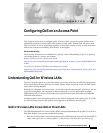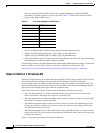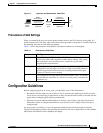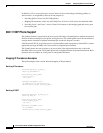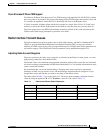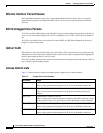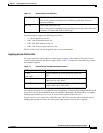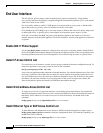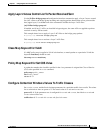
7-2
Cisco Wireless Router and HWIC Configuration Guide
OL-6415-03
Chapter 7 Configuring QoS on an Access Point
Understanding QoS for Wireless LANs
• Does not construct internal DSCP values; it only supports mapping by assigning IP DSCP,
precedence, or protocol values to Layer 2 CoS values. Table 7-1 lists the class of service (CoS)
values as they map to DSCP values.
• Carries out Enhanced DCF (EDCF)-like queuing on the radio egress port only.
• Support only 802.1Q/P tagged packets. Access points do not support ISL.
• Support only Cisco Modular QoS CLI (MQC) policy-map set cos action.
• Prioritize the traffic from voice clients (such as Symbol phones) over traffic from other clients when
the QoS Element for Wireless Phones feature is enabled.
To contrast the wireless LAN QoS implementation with the QoS implementation on other Cisco network
devices, see the Cisco IOS Quality of Service Solutions Configuration Guide at this URL:
http://www.cisco.com/univercd/cc/td/doc/product/software/ios122/122cgcr/fqos_c/index.htm
Impact of QoS on a Wireless LAN
Wireless LAN QoS features are a subset of the proposed 802.11e draft. QoS on wireless LANs provides
prioritization of traffic from the access point over the WLAN based on traffic classification.
Just as in other media, you might not notice the effects of QoS on a lightly loaded wireless LAN. The
benefits of QoS become more obvious as the load on the wireless LAN increases, keeping the latency,
jitter, and loss for selected traffic types within an acceptable range.
QoS on the wireless LAN focuses on downstream prioritization from the access point:
• The radio downstream flow is traffic transmitted out the access point radio to a wireless client
device. This traffic is the main focus for QoS on a wireless LAN.
• The radio upstream flow is traffic transmitted out the wireless client device to the access point. QoS
for wireless LANs does not affect this traffic.
• The Ethernet downstream flow is traffic sent from a switch or a router to the Ethernet port on the
access point. If QoS is enabled on the switch or router, the switch or router might prioritize and
rate-limit traffic to the access point.
• The Ethernet upstream flow is traffic sent from the access point Ethernet port to a switch or router
on the wired LAN. The access point does not prioritize traffic that it sends to the wired LAN based
on traffic classification.
Figure 7-1 shows the upstream and downstream traffic flow.
Table 7-1 CoS Values Mapped to DSCP Values
CoS Value DSCP Value
110
218
326
434
546
648
756



